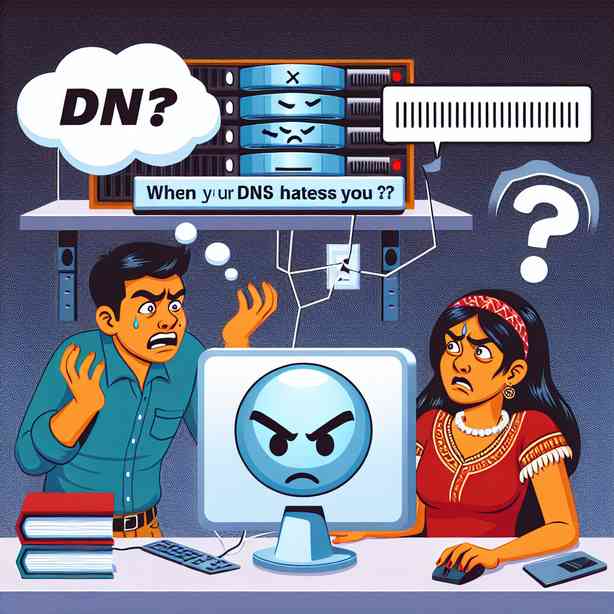
Certainly! Let’s dive into the topic of DNS, or Domain Name System, which plays a crucial role in how we interact with the internet.
—
Have you ever encountered issues while trying to access your favorite websites, only to be met with those frustrating error messages? These problems can often be traced back to DNS issues. Understanding how DNS works and what can go wrong can empower you to solve these challenges swiftly.
DNS serves as the phonebook of the internet. Instead of typing in long numerical IP addresses to access different websites, DNS allows users to enter easily memorable domain names. When you enter a URL into your browser, DNS translates that domain name into an IP address, enabling your computer to locate the server hosting that site. However, this highly efficient system can sometimes malfunction, leading to an experience where “Your DNS hates you.”
Several factors can contribute to this malfunction. One of the most common scenarios is a misconfigured DNS server. When your internet service provider (ISP) offers DNS services, they may experience temporary outages or delays. These issues can prevent you from resolving domain names, resulting in error messages like “DNS server not responding.” To troubleshoot, you may need to change your DNS settings manually. Many users opt for public DNS services like Google DNS or Cloudflare DNS, which often prove to be more reliable.
Another vital aspect to consider is DNS propagation. Whenever a domain name’s DNS settings are updated—such as when switching hosting providers or transferring domains—it takes time for these changes to propagate across the internet. This period can last from a few hours to a couple of days. During this time, some users may still reach the old server, while others are directed to the new one, creating inconsistencies. Understanding this process can help you set realistic expectations when making changes.
DNS caching also plays a significant role in how quickly websites load. Both your computer and your ISP cache DNS records to expedite future requests to the same site. However, if the cached information is outdated, it can lead to failed attempts to reach a website. Clearing your local DNS cache can sometimes resolve these issues. It’s a straightforward process, and you can do it through your operating system’s command line, whether you’re using Windows, macOS, or Linux.
Security is another critical element of DNS. In recent years, malicious attacks targeting DNS systems have increased, leading to vulnerabilities such as DNS spoofing. Attackers can redirect users to fake websites that look legitimate but are designed to steal sensitive information. Employing DNSSEC (Domain Name System Security Extensions) can add an additional layer of security by ensuring that the responses you receive to your DNS queries haven’t been tampered with.
It’s also essential to keep your devices and firmware up to date. Sometimes, the source of DNS faithlessness may lie within outdated networking equipment. Routers, modems, and other networking hardware can develop compatibility issues with the latest internet protocols. Manufacturers frequently release firmware updates that can resolve these issues, improve performance, and enhance security. So, a regular check on your hardware can be quite beneficial.
Additionally, consider that DNS is not only influenced by your local settings but can also be affected by your internet environment. If you are in an area with poor connectivity, you may experience more frequent DNS errors. In such cases, using a wired connection instead of Wi-Fi can sometimes resolve intermittent issues. Moreover, using a reliable VPN can bypass region-specific DNS limitations and deliver a more stable browsing experience.
Troubleshooting DNS issues can sometimes be as simple as resetting your network connection. If your internet goes down or you experience slow speeds, restarting your modem or router can often resolve temporary glitches. It’s a quick fix that many people overlook, but it can remedy numerous connectivity problems.
Understanding how DNS resolution works can also enhance your ability to troubleshoot effectively. When you enter a domain name, your computer follows a series of steps to resolve that name to an IP address. It starts by checking its local cache and then queries the designated DNS server. If the server doesn’t contain the needed information, it propagates the query up the hierarchy of DNS servers until it reaches the root DNS servers. Hence, understanding this chain of resolution can help you pinpoint where a breakdown might be occurring.
Sometimes, switching DNS servers can also solve issues if your current ISP-driven DNS is slow or problematic. As mentioned earlier, using a public DNS service, like those offered by Google or Cloudflare, can often provide faster resolution and greater reliability.
In conclusion, while encountering DNS issues can be surprisingly frustrating, understanding how DNS operates can streamline the process of diagnosing these problems. Whether it’s a misconfiguration, propagation delays, caching issues, or security threats, being informed allows you to tackle each situation with a more educated approach. By implementing best practices such as using public DNS services, keeping your hardware updated, and regularly resetting your network, you can minimize downtime and enhance your browsing experience. Never let your DNS get you down—take control of your internet experience with the knowledge and tools at your disposal.


